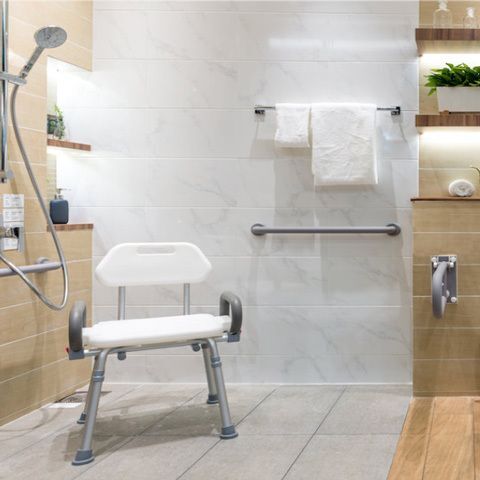
Five Things to Know about Home Assessments
Your Questions Answered!
Why is a home assessment important?
Take a look around your home with the future in mind. Are you able to safely access all areas in the kitchen for cooking your favorite meal? Can you easily exit and enter your home and access your bedroom and bathroom? Are the doorways wide enough for a walker or wheelchair? Can you access your shower safely? Can you participate in your daily activities with peace of mind?
A home assessment is an important step to take as we age in order to minimize our fall risk, allow us to maintain our independence with activities of daily living and allow us to remain in our home for as long as possible.
According to the Centers for Disease Control:
- Every year 14 million older adults sustain a fall w/ about 3 million resulting in an emergency room visit
- 1 out of 10 falls results in an injury that causes the older adult to restrict their activities for a day or more or to seek attention from the healthcare system
- In 2019, 83% percent of hip fracture deaths and 88% of emergency department visits and hospitalizations for hip fractures were caused by falls.
The CDC also shares that “the interventions with the potential to help the greatest number of older adults were those that provided home modifications delivered by an occupational therapist.”
There are a lot of risk factors that contribute to a fall, including decreased vision, medication side effects, environmental hazards, incontinence, decreased safety awareness/judgment, unsteady gait/reduced mobility, reduced lower body strength, chronic conditions and living alone. A home safety assessment can help seniors minimize the risk of falling by evaluating the home and making recommendations for modifications and equipment.
Who can do the assessment?
The Occupational Therapist is the best person to complete these home assessments due to their extensive knowledge and training using a holistic approach to each client by assessing the person, the environment and the occupations (activities of daily living).
- An Occupational Therapist’s (OT) role in the therapy process is to help an individual increase engagement in meaningful occupations (day to day activities such as dressing, cooking, spending time w/ grandkids, going to church, etc) in their home and community while minimizing their risk for falls and decreasing burden of care on their loved ones or caregivers.
- An OT can work in an individuals home/family members home, hospital, rehab facility or nursing home/assisted living facility.
- OT’s are specialists in modifying and environment, analyzing and adapting an activity, identifying and training on equipment to use for daily activities to improve safety and independence, in addition to improving strength, balance and cognition.
- An OT can work in collaboration with the rest of the care team including Physical Therapy, Speech Therapy, Caregivers, Physicians, and Case managers to address the needs of the person and get the best possible outcomes for them.
What does a home assessment look like?
The goal is to understand each person’s needs and wants, as well as where they perform their daily activities, in order to create a comprehensive plan to improve safety while maximizing independence.
A home assessment will typically include:
- An evaluation of the home’s accessibility and safety
- Assessing the client/caregiver engaging in daily activities that have become challenging
- Based on needs, an Assessment of an individual's strength, ROM, coordination, cognition, balance and vision may be completed
- Assessing and practicing mobility throughout the home
- Identifying safety risk factors that might limit daily activities or increase their risk for falling
- Making recommendations for modifications or equipment to improve safety and maximize independence
- Educating caregivers and/or family as needed
What home modifications might be recommended?
Here are some areas of the home that can be assessed, and modifications that could be recommended.
Bathroom
- Shower stall/tub
Add grab bars, convert tub into walk- in or roll in shower, add hand held shower head, add non slip rug outside of the shower, etc. - Toilet
Change standard commode to comfort height, add grab bars, add bidet, etc - Floors
Add non-slip rug, change flooring, etc. - Doorway
Increase door width, change/remove threshold, change doorknobs, change swing of the door, etc. - Lighting
Add night lights, add toilet bowl light, change overhead lighting, add motion activated lights, etc.
Kitchen
- Cabinets
Change knobs/handles, modify to allow access for wheelchair, decreased shelf height, install pull out shelves/lazy susan, etc. - Floors
Remove throw rugs, change flooring, etc. - Access to sink/stove/dishwasher
Smart appliances, modify counter height, add wheelchair accessible space, etc. - Lighting
Access to light switches, motion/voice activated, etc.
Bedroom
- Bed
Adjust the height, alternate bedding, change out pillows, add safety rail, etc. - Access to closets
Move furniture, change door swing direction, change knobs/handles, lower rod, etc. - Floors
Remove throw rugs, change flooring, etc. - Doorways
increase door width, change door knobs, change door swing, change/remove threshold, etc. - Lighting
Increase access to light switches/lamps, voice/motion activated lighting, etc.
Exterior
- Doorways/Doors
Widen doorways, install grab bars, change door knob/locks, change door swing, etc. - Sidewalk conditions
Change sidewalk surface for non slip - Stairs
Add hand rails, convert to ramp, add stair lift/wheelchair lift, etc. - Lighting
Motion activated lights, increase lighting, etc. - Safety
Add video doorbell, smart locks, monitoring systems for loved ones that wander, motion detected cameras, etc.
Stairwells
- Lighting
Motion activated lighting, increase the amount of lighting, access to light switches, etc. - Stairs
Add rails, add visual markers for low vision, stair lifts, etc.
How do I get started?
- Get a referral/order from your physician.
- Reach out to an agency with a certified home assessment therapist.
- Determine how you will pay (insurance or private pay) based on your medical status and/or needs.
- Schedule your home assessment!
Want to Learn More?
- Learn more about our mobile therapy services at Bal Therapy LLC
- For a free safety checklist to help determine if a home assessment is needed, go to: https://www.cdc.gov/steadi/pdf/steadi-brochure-checkforsafety-508.pdf
- For more information regarding home safety assessments and modifications: https://www.aarp.org/caregiving/home-care/info-2019/safety-tips.html
- For more information on other programs to minimize fall risk: https://www.novafallsprevention.com/
Author
Jacqueline “Jaci” Green, OTR/L, LSVT certified, Certified Home Accessibility Therapist for Bal Therapy
Jaci’s passion for health and well-being has drawn her to help individuals achieve their goals through occupational therapy. She has 13 years of experience working in many fields including inpatient rehab, skilled nursing facilities, assisted living facilities, outpatient pediatrics, academia, home health and mobile outpatient. For the past 3 years, she has worked for a mobile outpatient company by the name of Bal Therapy. While working for Bal Therapy, Jaci was able to obtain certifications in LSVT (Parkinson’s specific training program) and home assessments to advance her practice and ability to help her clients maximize their independence and remain in their homes for as long as possible. Her areas of interest include stroke, Parkinson’s, dementia, health management and home modifications. She enjoys assisting clients to get back to the daily activities that they enjoy—-whether that is cooking a meal for their family, remaining at home as they age, playing catch with their grandchildren or being able to put on their best outfit to go dancing w/ their spouse.
Jaci is originally from Pennsylvania, but now lives in Falls Church, VA with her boyfriend and 2 cats “Nittany” and “Joe Paw”. In her free time, she enjoys reading, wine tasting and spending time with friends.
Insight Blog
Read More







